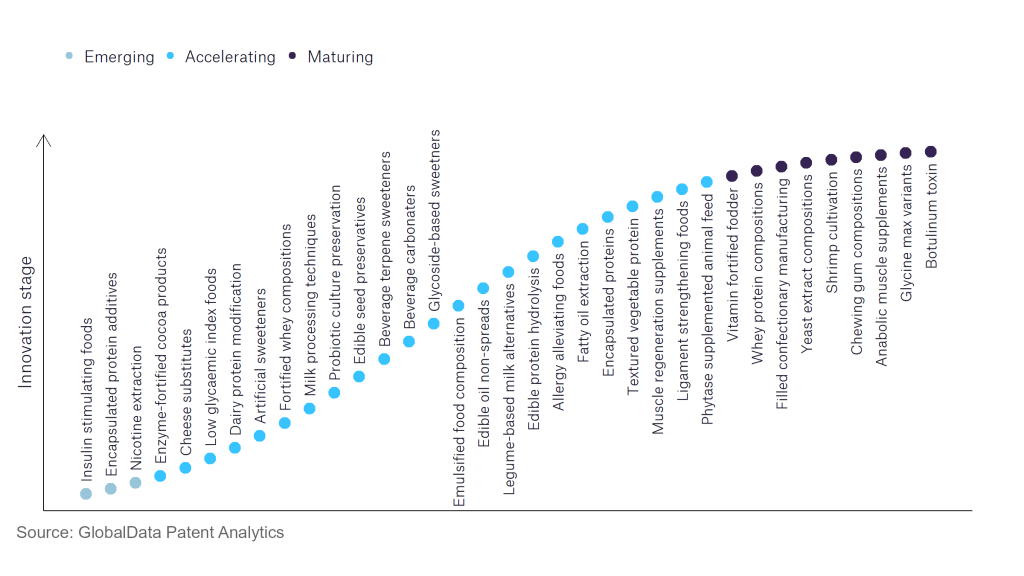The consumer industry continues to be a hotbed of innovation, with activity driven by health and wellness, environmental sustainability, convenience, and aesthetics, and growing importance of technologies such as food safety and transparency, digital food management, 3D food printer, personalised nutrition, food waste reduction, and robotics. In the last three years alone, there have been over 450,000 patents filed and granted in the consumer industry, according to GlobalData’s report on Innovation in Consumer: Shrimp cultivation. Buy the report here.
However, not all innovations are equal and nor do they follow a constant upward trend. Instead, their evolution takes the form of an S-shaped curve that reflects their typical lifecycle from early emergence to accelerating adoption, before finally stabilising and reaching maturity.
Identifying where a particular innovation is on this journey, especially those that are in the emerging and accelerating stages, is essential for understanding their current level of adoption and the likely future trajectory and impact they will have.
40+ innovations will shape the consumer industry
According to GlobalData’s Technology Foresights, which plots the S-curve for the consumer industry using innovation intensity models built on over 110,000 patents, there are 40+ innovation areas that will shape the future of the industry.
Within the emerging innovation stage, hydrogel dressings, dextrin-based compositions, and safety injection needles are disruptive technologies that are in the early stages of application and should be tracked closely. Wet wipes dispenser, carbon fibre sports equipment, and cigarette rod making device are some of the accelerating innovation areas, where adoption has been steadily increasing. Among maturing innovation areas are portable toothbrush cases and anabolic muscle supplements, which are now well established in the industry.
Innovation S-curve for the consumer industry

Shrimp cultivation is a key innovation area in consumer
Shrimp cultivation refers to the farming of shrimps or prawns either in freshwater or marine environments.
GlobalData’s analysis also uncovers the companies at the forefront of each innovation area and assesses the potential reach and impact of their patenting activity across different applications and geographies. According to GlobalData, there are 20+ companies, spanning technology vendors, established consumer companies, and up-and-coming start-ups engaged in the development and application of shrimp cultivation.
Key players in shrimp cultivation – a disruptive innovation in the consumer industry
‘Application diversity’ measures the number of different applications identified for each relevant patent and broadly splits companies into either ‘niche’ or ‘diversified’ innovators.
‘Geographic reach’ refers to the number of different countries each relevant patent is registered in and reflects the breadth of geographic application intended, ranging from ‘global’ to ‘local’.
Patent volumes related to shrimp cultivation
| Company | Total patents (2021 - 2023) | Premium intelligence on the world's largest companies |
| Hefei Kangqingyuan Breeding | 27 | Unlock Company Profile |
| SHV Holdings | 26 | Unlock Company Profile |
| Suzhou Xiangcheng Yangchenghu Jianmei Aquatic Product Ecological Cultivation Specialized Cooperatives | 20 | Unlock Company Profile |
| Nippon Suisan Kaisha | 19 | Unlock Company Profile |
| Tongwei | 18 | Unlock Company Profile |
| Planktonic | 16 | Unlock Company Profile |
| Weber Ultrasonics | 16 | Unlock Company Profile |
| Zhuhai Rongchuan Feed | 15 | Unlock Company Profile |
| Royal DSM | 13 | Unlock Company Profile |
| Commonwealth Scientific and Industrial Research Organisation | 12 | Unlock Company Profile |
| INVE TECHNOLOGIES | 12 | Unlock Company Profile |
| Lucent Biosciences | 12 | Unlock Company Profile |
| Previwo | 11 | Unlock Company Profile |
| Guangzhou Haihao Investment | 10 | Unlock Company Profile |
| Tianjin Chenhui Feed | 9 | Unlock Company Profile |
| Ajinomoto | 8 | Unlock Company Profile |
| Toray Industries | 8 | Unlock Company Profile |
| Blue Aqua International | 7 | Unlock Company Profile |
| Shin Nippon Biomedical Laboratories | 7 | Unlock Company Profile |
| Kirin Holdings | 7 | Unlock Company Profile |
| Fujian Aonong Biological Technology Group Incorporation | 6 | Unlock Company Profile |
| LiveFuels | 6 | Unlock Company Profile |
| AlzChem Trostberg | 6 | Unlock Company Profile |
| Emerson Electric | 5 | Unlock Company Profile |
| Nireus Aquaculture | 5 | Unlock Company Profile |
| Lu Hui | 5 | Unlock Company Profile |
Source: GlobalData Patent Analytics
Leading companies in the shrimp cultivation space in terms of patents filed are Hefei Kangqingyuan Breeding, SHV Holdings, Suzhou Xiangcheng Yangchenghu Jianmei Aquatic Product Ecological Cultivation Specialized Cooperatives, and Nippon Suisan Kaisha. Recently, Nippon Suisan Kaisha has started selling its shrimp products in the US market under the Gorton’s brand.
Leading companies in terms of application diversity are Previwo, Planktonic, LiveFuels, and Ajinomoto.
Leading companies in terms of geographic reach are Inve Technologies, Shin Nippon Biomedical Laboratories, SHV Holdings, and Lucent Bioscience.
With the demand for shrimps rising across the world, shrimp cultivation farms are expected to grow in numbers in the coming years.
To further understand the key themes and technologies disrupting the consumer industry, access GlobalData’s latest thematic research report on Consumer.
Data Insights
From

The gold standard of business intelligence.
Blending expert knowledge with cutting-edge technology, GlobalData’s unrivalled proprietary data will enable you to decode what’s happening in your market. You can make better informed decisions and gain a future-proof advantage over your competitors.



